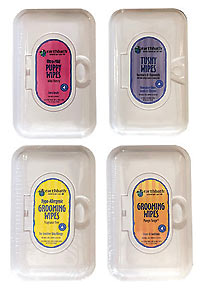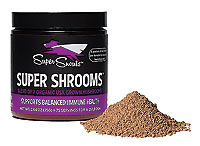 |
| Hypo-Allergenic grooming Wipes |
Pets are generally much smaller than we are, with much smaller organs of elimination like the liver, kidneys and lungs. When exposed to toxins, their bodies have to work much harder than ours to eliminate them. Pets also have a shorter life span; they do not have the luxury of time that we have for their bodies to eliminate toxins gradually. Our pets can’t talk to let us know when something in their food or their environment is making them feel sick, they can’t switch their own food or decide to stop using a household cleaner that irritates their lungs. Since we control our pet’s environment, they rely on us 100% to reduce toxins they encounter.
Toxins get into your pet through several means. Some are accidentally ingested, outdoor toxins like weed killers, pesticides and lawn and garden fertilizers get in to pets when they breathe them in, eat chemical laden grass, lick dust or residue off their paws or fur, or absorb them through their paws. Other environmental toxins arrive the same way from cleaners, air fresheners, laundry products and other household chemicals. More toxins can be directly ingested in your pet’s drinking water, in commercial treats and food, and in over the counter or prescription medications they take. Some toxins are produced within your pet’s body; whether through their metabolic processes or by microbial activity, most often bacteria and yeast in the GI tract.
In a healthy body, toxins are rounded up and eliminated quickly through the organs of elimination (liver, kidneys, lungs, intestines and skin). Our pets are bombarded daily with an overwhelming number of toxins, most of which their bodies have had not had enough evolutionary time to adapt to. Our pet’s bodies react to toxins as ours do – the immune system ramps up processes like inflammation, mucus production or diarrhea to help the immune system resolve the problem and purge the toxins from their system.
When the body is overwhelmed with too many toxins, it is forced to store them until there is an opportunity to eliminate them. For many pets, this time never arrives, and toxins can accumulate indefinitely, where over time they can cause symptoms like lethargy, fatigue and proneness to infection. Toxic overload can impede the work of your pet’s immune system to the point where tumors or cysts may form and other serious health conditions may develop as cells degrade and organ function is impaired.
Taking these steps will help detox your pet:
Upgrade Food and Treats – Improving the quality of your pet’s diet is always the very best thing you can do to improve well-being and longevity. If you are giving your pets any low cost commercial food and treats, you are definitely giving them a dose of chemical additives, artificial colors and flavors with every bite. Many brands of food and treats have plenty of these toxic indigestible ingredients, along with poor quality proteins and fillers that tax your pet’s digestion and increase the toxic load on their bodies. Choose natural food and treats. We offer only the best in highly digestible, additive free foods in kibble, freeze dried, canned as well as frozen meals for your cat or dog. We all so have free samples of almost every food we carry in the store so you can try and new and better food with your pet.
Filtered Water Only – While the water that flows through your household pipes may be technically fit to drink, it contains enough toxic mineral and metal levels, chemicals like fluoride and chlorine and even trace amounts of hormone-like compounds. Your pets deserve better. Water filtration units are readily available and you do not have to spend a lot to get a good one.
Eliminate Household Chemicals – Beside the obvious chemicals in bug killers, cleaning products and solvents, beware of those found in perfumes, air fresheners, scented plug-ins, laundry products and even dryer sheets. These are laden with chemicals typically unregulated and untested by US health protection agencies and many of them are known to cause or worsen respiratory conditions like asthma in people and pets. Look for 100% natural cleaning products, or make your own.
Improve Air Quality – Indoor air pollution can come from household chemicals and it should be well understood that pets are affected by the toxins in cigarette smoke. Toxins in the air also come from chemicals outgassing from synthetic household items like flooring, carpeting and furniture. If you have items that are giving off that tell-tale new smell, be sure to keep pets off and out of these areas and consider using fans or leaving windows open for some fresh air while these items are exuding high levels of chemical residues.
Minimize Exposure to Outdoor Pollutants & Chemicals – pets that spend time outdoors will undoubtedly encounter chemicals used for pest control, weed killer, fertilizers and more. If your dog likes to eat grass or other plants, keep a close eye on them when you are walking near other people’s yards and in public places like parks. Adding greens to their diet may help curb this tendency in both cats and dogs. For cats, a great solution is the Petlinks Nibilicious Seed Kit, which lets you grow healthy oat grass free of contaminants. For dogs a great option is Steve’s Real Food Carnaforage, a freeze dried raw goat’s milk probiotic that is blended with spirulina, dandelion and milk thistle.
 Support The Liver – Your pet’s liver does the lion’s share of toxin elimination. Antioxidants can assist the liver and many detoxification remedies have herbs like milk thistle that can be of great value to your pet’s liver. Many pets will not require daily liver support, older pets and those taking daily medications may benefit from regular use of liver support products. Support The Liver – Your pet’s liver does the lion’s share of toxin elimination. Antioxidants can assist the liver and many detoxification remedies have herbs like milk thistle that can be of great value to your pet’s liver. Many pets will not require daily liver support, older pets and those taking daily medications may benefit from regular use of liver support products.
Provide Immune Support – Your pet’s immune system works in tandem with the elimination organs to keep your pet well, and supporting immune health keeps your pet’s liver, kidneys, lungs, intestines and skin healthy so they can do their detoxification work. For healthy pets, daily immune support is found in a quality multivitamin and mineral supplement. Brands like Nupro, Carna4, Earth Animal, and Super Snoots make a variety of immune boosting supplements for many different needs.
Skin Salvation – Cats and dogs eliminate toxins through their skin and a regular brushing regimen will help your pet’s skin breathe and facilitate this process. Regular grooming also removes dust and debris that may contain toxic residue. Wipe your pet down regularly after a trip outside to reduce pollen, dust, and pest off your pet and out of your house. A quick moment with a wet towel at the door can make all the difference. Also consider the quality of the bath products you use and choose natural products that skip the toxic ingredients so your pet absorbs fewer toxins at bath time.
Keep It Clean – Keeping your home free of dust with regular dusting and vacuuming can greatly reduce the toxic particulate that your pets end up ingesting. Another place to be strict with cleaning is your pet’s water and food bowls. Change water daily and wash your pet’s bowls, as dust and germs accumulate here in abundance.
NEVER LEAVE YOUR PET IN THE CAR
On sunny and warm days, the air in the car doesn’t circulate and the temperature can rise within minutes to a point where it can become life threatening. Even if the windows are cracked, cars heat up quickly and your pet can be in danger.
For example, a 70 degree day will quickly heat up to 104 degrees inside the car. |
Dog-Friendly Walks/Hikes
in the Moab Area |
Corona Arch - Easy/Moderate. 1.3 Miles one way. Trailhead is 25 minute drive from Moab. North on US-191 to Potash Road (Utah 279).
Mill Creek Pathway - Easy. 1.1 Miles. Little to no driving. Starts at the intersection of 100 South and 100 West, a block off of Main Street.
Portal Overlook - Hard. 2.0 Miles one way. Trailhead is 20 minute drive from Moab. N. on US-191 to Potash Road (Utah 279).
Grandstaff Canyon - Moderate. 2.0 Miles one way. Trailhead is 10-minute drive from Moab. North on US-191 to the River Road (Utah 128) |
|